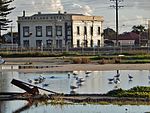Semaphore Library

The Semaphore Library is a heritage-listed library and former town hall and cinema at 14 Semaphore Road, Semaphore, South Australia. It was formerly the Semaphore Institute, Semaphore Town Hall, Ozone Theatre and Semaphore Cinema. It was listed on the South Australian Heritage Register on 1 September 1983, and was also listed on the Register of the National Estate.It was built as the Semaphore Institute, an early mechanics institute, and opened on 15 March 1884. It was designed by architects Wright and Reed, and built by Williams & Cleave. It was a stone building with an iron roof, with a main hall and stage, entrance room, library and reading room on the ground floor, and offices for the local municipality, the Corporate Town of Semaphore, and a gallery on the second floor. In 1889, it was sold to the municipality to be used as the Semaphore Town Hall. The municipality merged with the adjacent Corporate Town of Port Adelaide in 1900, but it continued to be rented out for community events by the Port Adelaide council. From 1910, the hall was used as a temporary cinema by a number of organisers, while continuing to be used for other community functions. In 1929, Ozone Amusements leased the hall from the Corporate Town of Port Adelaide and converted the hall into a permanent cinema to a design by Chris A. Smith, adopting a range of Art Deco features. Smith was a prominent architect of the period, designing many theatres and cinemas, and a number of public buildings including a refurbishment of the Brighton Town Hall. The company later became Ozone Theatres, and would become one of the two major movie chains in South Australia. In 1951, Hoyts bought out the Ozone company, and in 1952 undertook a complete refurbishment of the Semaphore cinema, reopening on 20 November. However, box office takings suffered from the introduction of television, and Hoyts closed the cinema on 21 May 1960.The ground floor was used by the Semaphore Youth Club from 1966 to 1978, and in 1977 a smaller cinema, the Semaphore Cinema, was opened in what had been the upstairs dress circle by Alan and Fran Hall, operating until its closure in 1985. The building was vacant from 1985 to 1993, when the City of Port Adelaide restored the building as the Semaphore Library, which it has operated as ever since. The building remains substantially intact from its previous uses, and its state heritage listing notes that "enough interior elements of both periods [as a cinema] remain for it to be quite a significant representative of suburban cinemas in their heyday."
Excerpt from the Wikipedia article Semaphore Library (License: CC BY-SA 3.0, Authors, Images).Semaphore Library
Institute Lane, Adelaide Semaphore
Geographical coordinates (GPS) Address Website Nearby Places Show on map
Geographical coordinates (GPS)
| Latitude | Longitude |
|---|---|
| N -34.838679 ° | E 138.481337 ° |
Address
Port Adelaide-Enfield Council Library, Semaphore Branch
Institute Lane
5019 Adelaide, Semaphore
South Australia, Australia
Open on Google Maps




